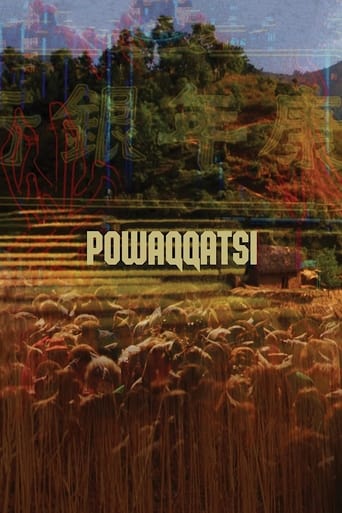Dalbert Pringle
Well, when it came to Powaqqatsi's camera-work, I certainly had nothing to really complain about in regards to that. Overall, it was quite excellent and impressive to behold.But, with that said, I honestly have to admit that viewing recurring images of 3rd World poverty and population overload (set at a gruellingly slow pace) did, indeed, become quite tiresome to sit through, in the long run.In fact, I ended up watching most of Powaqqatsi in fast-forward mode - 'Cause I knew that I just couldn't have endured viewing it, from start to finish, at its full 99-minute running time. No way.Powaqqatsi was directed by Godfrey Reggio. Its budget was $2.5 million.
Roger Burke
The imagery, metaphors and sound track in this, the second of the Glass/Reggio trilogy, are, in my opinion, better than those in Koyanisqatsi (1982). As much as I admired the latter, it did concentrate on the 'life-out-of-balance' scene in USA, to the exclusion of the bulk of the world's population.Powaqqatsi redresses that imbalance...and adds the second chapter in this trilogy.First, a few words about the music, a choral and orchestral mix that is simply spine-chilling and transcendental at the same time, a thematic tour-de-force that celebrates the almost tireless strength and perseverance of today's pre-industrial world, which encompasses South America, Africa, India and China. It's worth seeing this film just to listen to that music, in my opinion.The visual, however, is just as compelling, beginning – and briefly ending – with scenes from an earthly hell: the gold mines at Serra Pelada – Bald Mountain – somewhere in Brazil, where the workers march to the lure of riches, accompanied by staccato tom-toms, to carry bags of gold-flecked earth to the top of a ridge for collection. This is work at its meanest... and often most grueling, as shown by two men bearing a stricken worker on their backs to the top.But, it's not all bad. Sparkling images of boats on the sea; glistening sunlight shimmering; a lone eagle silhouetted against an evening sun; masses of people celebrating in dance; reflections, in water, of people walking; an amazing shot of a tree reflected in water...All of which segues into the modern accoutrements that enhance and yet which begin the process of enslavement to the god of consumerism: trains in motion; videos on TV; the crowded commercial areas in China, Africa and India (watching a cricket game, no less); industrial smog; garbage dumps; bizarre bazaars; international trade; commuter trains and boats, staggering under the load of humanity that joins the daily rush, rush, rush...except for one little girl who stops and stares at the camera for the longest time, watching, thinking, wondering...You could argue, I suppose, that the negative side of industrial development is over-done; I'm sure many would see this film in that regard. However, considering the time that this film was made – twenty years ago – I tend to think that the negativity is appropriate because much is now worse, particularly in China and India, where unchecked development is – literally – a smoking time bomb of industrial pollution.Powaqqatsi's message about life on earth going the wrong way is spot on: from the despair in the eyes of workers as they grind away at their wheels or machines, to somber children facing the camera, to once again the symbolically crucified worker on the backs of his co-workers at Serra Pelada, every person who sees this must pause and reflect upon themselves and their purpose on this earth, however imperfectly, just as those who, in the final scene, often see themselves reflected in shimmering water – but ever moving, walking, jostling forward to, we all hope, better times and bigger rewards.At the end of this film, the viewer learns that powaqqatsi is formed by the combination of two Hopi Indian words: 'powaq', meaning 'sorcerer' and 'qatsi' meaning 'life'. Thus – life sorcerer, one who has power over life and death.Was it Pogo who said: I have seen the enemy and they is us? See this movie and answer for yourself.
Polaris_DiB
I'd say this is probably the best of the Qatsi trilogy thematically. Koyaanisqatsi is the best with flowing, beautiful imagery, but this one has a much more gripping and interesting experience.One of the things that Reggio is amazing at is capturing faces. This movie has the best faces of the Qatsi trilogy, something that makes it personal and maybe a bit more damning. That little child with the horses is probably one of the most haunting images in the entire trilogy.Also, this one uses montage editing techniques to a much greater degree of meaning. Koyaanisqatsi had some fairly amazing graphic matches connecting city maps with computer chips, but this one really causes the imagery to react with each other to provide the feeling of people getting run down and advertising trying to wash away the flames of destruction caused in developing countries. There's just so much more symbolic meaning, I think, in this one.And of course it's head and shoulders above Naqoyqatsi. Both of them are.--PolarisDiB
bowa
I saw Koyaanisqatsi several times in the late eighties and was truly mesmerized. After that Powaqqatsi was a true disappointment. I didn't understand it, to be honest.Many years later I bought the DVDs and saw them both recently. I still like Koyaanisqatsi, even if it couldn't meet my great expectations. But now Powaqqatsi emerged as a true beauty!I find the photography and music far superior to that of Koyaanisqatsi. Real people, instead of land- and cityscapes (even if wonderful). Some of the Powaqqatsi scenes are simply breathtaking. African women in clear red cloth against the desert sand, the introductory (horrible) scene from the Brazilian mine, etc, etc.I strongly recommend all those that were utterly disappointed 10 years ago to see Powaqqatsi again!


